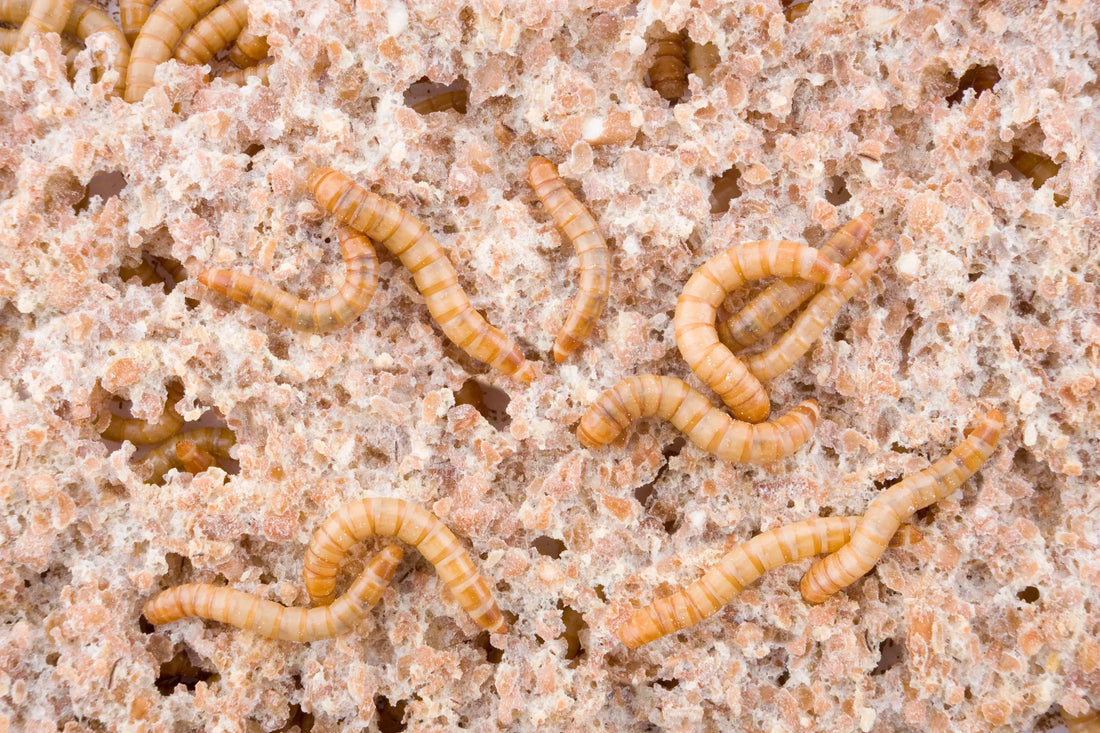
Feeding Mealworms: Complete Guide for Growth and Pet Nutrition
Share
Mealworms can eat just about anything
Mealworms can eat just about anything: fruit, vegetables, dry grains, food waste – even cardboard and plastic! But to get the most nutrition for your pet, you probably want to avoid the all-plastic diet.
Feeding Mealworms: Practical Feed Guide Based on Research
Many studies have looked at how diet affects mealworm growth and survival, showing that the type of food is less important than the nutrients they get. A study on the effect of food types found that, when nutritional needs are met, diet has no major effect on insect performance, productivity or larval growth, with only slight (less than 1 mg) changes in larvae weight found. Researchers found that a protein-biased diet reduced lifespan. When given a choice, mealworms preferred a carbohydrate-biased diet.
Common feed includes wheat bran, barley, millet grain, and corn starch. To improve growth, add proteins, fats, moisture, and vitamins. Research found supplementing wheat with 10% yeast protein increased larval weight by 1000%.
A large evaluation of over 40 feed types showed cereal flours had the lowest mortality. Oat flour raised mortality to 16%. Soybean flour reduced growth due to a trypsin inhibitor.
Best Foods for Feeding Mealworms
- Wheat bran
- Hen feed
- Buckwheat
- Rye flour
Using Food Waste for Feeding Mealworms
A study into 3 household wastes found watermelon waste was best, followed by banana peel. Mixed vegetable waste can reduce protein content and increase mortality.
Can Mealworms Eat Meat?
Mealworms should be treated as vegetarians. In extreme conditions, they may eat meat, but wet pet food is a safer protein source.
Do Mealworms Need Water?
Mealworms absorb moisture from the air and prefer humidity. Avoid bowls of water; use wet vegetables or damp sponges for hydration. Carrots and potatoes are ideal.
Feeding Mealworms to Pets: Nutritional Cautions
When feeding mealworms to reptiles or birds, ensure calcium is supplemented. Impaction and calcium deficiency may occur without supplements. Thin eggshells and rickets are common issues.
Gut Loading vs Dusting Mealworms
Dusting means coating mealworms with calcium powder before feeding. Gut loading involves pre-feeding calcium-rich diets. Studies show calcium peaks after 2–4 days of gut loading. Extended feeding may lower calcium levels.
Feeding Mealworms and Frass Quality
Mealworm diet affects frass composition. Mealworm frass varies by input diet. A study compared 3 diets:
- Diet A: 66% carbs, 6% fat, 28% protein
- Diet B: 77% carbs, 6% fat, 28% protein
- Diet C: 49% carbs, 12% fat, 39% protein
Diet C produced frass with double the nitrogen content, while Diet A improved plant stress resistance.
Summary: Best Practices for Feeding Mealworms
Use dry grains like wheat bran, buckwheat, or rye as the base. Add yeast or lentils for protein. Include fruits or vegetables for moisture. Avoid meat. For pets, gut load or dust mealworms with calcium. This guide ensures you're feeding mealworms in a way that supports both insect and pet health.
